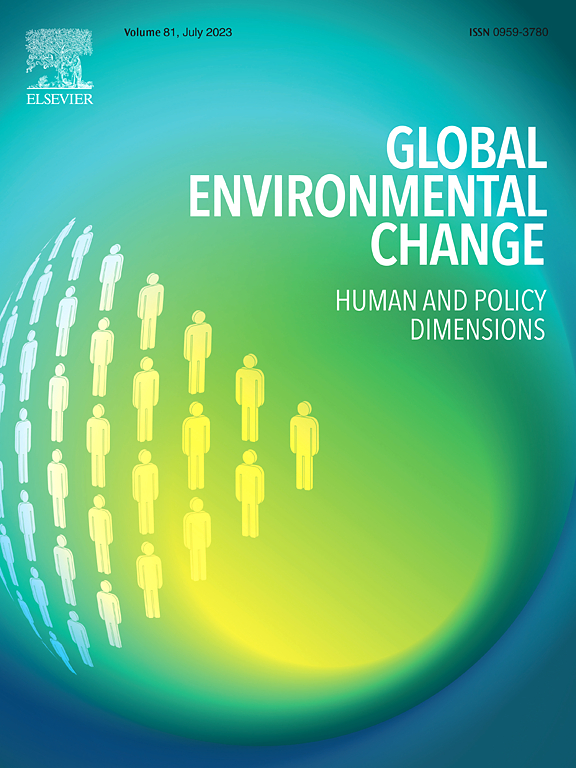“Sometimes, I just want to scream”: Institutional barriers limiting adaptive capacity and resilience to extreme events
IF 9.1
1区 环境科学与生态学
Q1 ENVIRONMENTAL SCIENCES
引用次数: 0
Abstract
Climate change is increasing atmospheric river risk, requiring communities to build resilience and implement adaptation strategies. Effective infrastructure and emergency management are two adaptations required for communities to cope with, and respond to, acute impacts of climate-related extreme events. In 2021, Fraser Valley, British Columbia, Canada experienced an unprecedented, yet anticipated, atmospheric river that exceeded risk-mitigation infrastructure and emergency management capacity. We ask: if they knew, why were they not prepared? Through a review of strategic planning documents and a qualitative analysis of semi-structured, key actor interviews, we analyze the impact of adaptive capacity on adaptation implementation. Our findings demonstrate that institutional barriers limited adaptive capacity, stagnated adaptation implementation and, in consequence, existing infrastructure and emergency management were insufficient to prevent acute impacts during the event. Further discussion identified formal and informal institutions preventing adaptation implementation: Formally, hierarchical governance decreased community adaptive capacity and led to infrastructure deficit, while informally, development-driven decision-making overshadowed infrastructure mitigation and preparedness priorities. Historical anthropocentric decisions persisted through path dependencies, preventing resilient decision-making during a time of rapid change. Recommendations are made to address these barriers and empower communities to prepare for climate change. This research offers understanding on institutional barriers limiting adaptive capacity and, more generally, contributes to a growing body of research that elucidates why communities face climate change underprepared.

“有时候,我只想尖叫”:制度障碍限制了对极端事件的适应能力和恢复能力
气候变化正在增加大气河流风险,需要社区建立抵御能力并实施适应战略。有效的基础设施和应急管理是社区应对和应对与气候有关的极端事件的严重影响所需的两项适应措施。2021年,加拿大不列颠哥伦比亚省弗雷泽谷经历了一次前所未有的、意料之中的大气河流,超出了风险缓解基础设施和应急管理能力。我们问:如果他们知道,为什么他们没有准备?通过对战略规划文件的回顾和对半结构化、关键行为者访谈的定性分析,我们分析了适应能力对适应实施的影响。我们的研究结果表明,制度障碍限制了适应能力,使适应实施停滞不前,因此,现有的基础设施和应急管理不足以防止事件期间的急性影响。进一步讨论确定了妨碍实施适应措施的正式和非正式机构:在正式情况下,等级治理降低了社区适应能力,导致基础设施不足,而在非正式情况下,发展驱动的决策掩盖了基础设施缓解和备灾的优先事项。历史上以人类为中心的决策通过路径依赖而持续存在,在快速变化时期阻碍了弹性决策。提出了解决这些障碍的建议,并赋予社区应对气候变化的能力。这项研究提供了对限制适应能力的制度障碍的理解,更广泛地说,有助于越来越多的研究阐明为什么社区面对气候变化准备不足。
本文章由计算机程序翻译,如有差异,请以英文原文为准。
求助全文
约1分钟内获得全文
求助全文
来源期刊

Global Environmental Change
环境科学-环境科学
CiteScore
18.20
自引率
2.20%
发文量
146
审稿时长
12 months
期刊介绍:
Global Environmental Change is a prestigious international journal that publishes articles of high quality, both theoretically and empirically rigorous. The journal aims to contribute to the understanding of global environmental change from the perspectives of human and policy dimensions. Specifically, it considers global environmental change as the result of processes occurring at the local level, but with wide-ranging impacts on various spatial, temporal, and socio-political scales.
In terms of content, the journal seeks articles with a strong social science component. This includes research that examines the societal drivers and consequences of environmental change, as well as social and policy processes that aim to address these challenges. While the journal covers a broad range of topics, including biodiversity and ecosystem services, climate, coasts, food systems, land use and land cover, oceans, urban areas, and water resources, it also welcomes contributions that investigate the drivers, consequences, and management of other areas affected by environmental change.
Overall, Global Environmental Change encourages research that deepens our understanding of the complex interactions between human activities and the environment, with the goal of informing policy and decision-making.
 求助内容:
求助内容: 应助结果提醒方式:
应助结果提醒方式:


